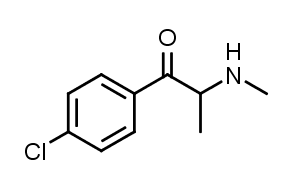4-Chloromethcathinone
4-Chloromethcathinone (4-CMC) is a psychoactive drug and research chemical belonging to the cathinone class. Cathinones are a subcategory of amphetamines, sharing core structural similarities but differing significantly in their effects and legal status. 4-CMC is closely related to methcathinone, differing only by the addition of a chlorine atom at the 4 position on the phenyl ring.
Chemistry[edit | edit source]
4-Chloromethcathinone is a synthetic cathinone with the molecular formula C10H12ClNO. It features a core phenethylamine structure with an alkyl group attached to the alpha carbon and an oxygen group attached to the beta carbon. The chlorine atom at the 4 position of the phenyl ring distinguishes it from other synthetic cathinones. This modification is thought to affect its pharmacokinetics, potency, and toxicity, although comprehensive studies on these aspects are limited.
Pharmacology[edit | edit source]
The pharmacological action of 4-CMC is primarily as a central nervous system stimulant. Like other cathinones, it is believed to work by increasing levels of dopamine, norepinephrine, and serotonin in the brain, leading to its stimulant and euphoric effects. However, the exact mechanism of action, especially how the chlorine substitution influences its effects compared to other cathinones, remains poorly understood due to the lack of scientific research.
Effects[edit | edit source]
Users of 4-CMC report a range of effects similar to those of other stimulants, such as increased energy, euphoria, enhanced sociability, and increased alertness. However, adverse effects are also reported, including paranoia, anxiety, hypertension, and potential neurotoxicity. The severity and duration of these effects can vary widely among individuals, depending on the dose, route of administration, and personal sensitivity.
Legal Status[edit | edit source]
The legal status of 4-CMC varies by country, with some countries having explicitly banned its possession, sale, and distribution, while in others, it remains a legal grey area, not specifically listed in drug control laws. Its status often reflects broader legislative trends concerning new psychoactive substances (NPS) and synthetic cathinones.
Health Risks[edit | edit source]
Due to its relatively recent emergence as a recreational drug, the long-term health risks associated with 4-CMC use are not well-documented. However, it is reasonable to assume that risks similar to those associated with other stimulants and synthetic cathinones—such as dependency, cardiovascular problems, and mental health issues—may apply. The addition of the chlorine atom could also introduce unique toxicological profiles that are not yet fully understood.
Conclusion[edit | edit source]
4-Chloromethcathinone represents a part of the ongoing challenge posed by new psychoactive substances to public health, legal systems, and drug policy. The lack of comprehensive data on its effects, potency, and risks underscores the need for further research and monitoring of synthetic cathinones and similar substances.
- Need help finding a doctor or specialist anywhere in the world? WikiMD's DocFinder can help with millions of doctors!
| This article is a stub. Help WikiMD grow by registering to expand it. |
Navigation: Wellness - Encyclopedia - Health topics - Disease Index - Drugs - World Directory - Gray's Anatomy - Keto diet - Recipes
Search WikiMD
Ad.Tired of being Overweight? Try W8MD's physician weight loss program.
Semaglutide (Ozempic / Wegovy and Tirzepatide (Mounjaro) available.
Advertise on WikiMD
WikiMD is not a substitute for professional medical advice. See full disclaimer.
Credits:Most images are courtesy of Wikimedia commons, and templates Wikipedia, licensed under CC BY SA or similar.
Contributors: Prab R. Tumpati, MD

